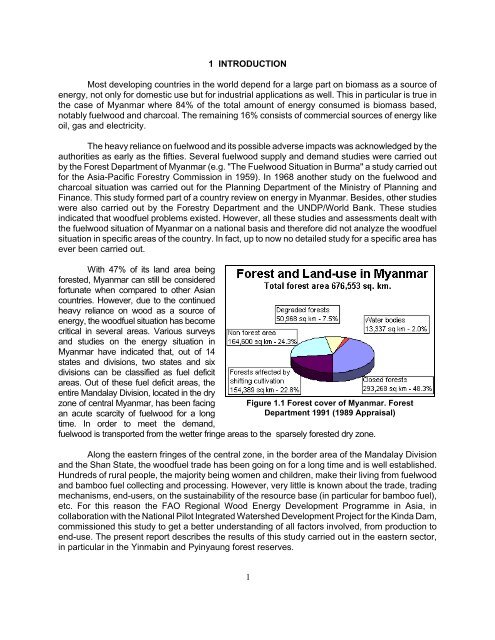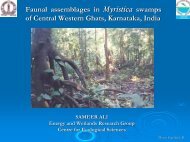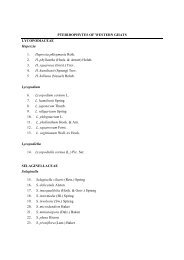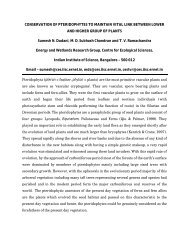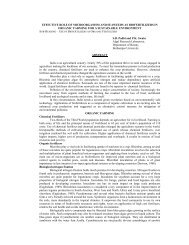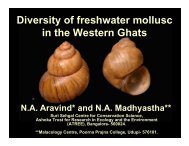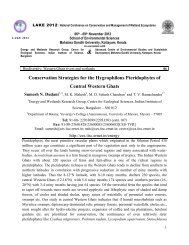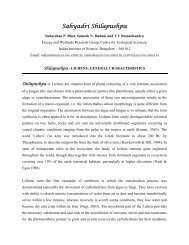regional wood energy development programme in asia ... - CES (IISc)
regional wood energy development programme in asia ... - CES (IISc)
regional wood energy development programme in asia ... - CES (IISc)
Create successful ePaper yourself
Turn your PDF publications into a flip-book with our unique Google optimized e-Paper software.
1 INTRODUCTION<br />
Most develop<strong>in</strong>g countries <strong>in</strong> the world depend for a large part on biomass as a source of<br />
<strong>energy</strong>, not only for domestic use but for <strong>in</strong>dustrial applications as well. This <strong>in</strong> particular is true <strong>in</strong><br />
the case of Myanmar where 84% of the total amount of <strong>energy</strong> consumed is biomass based,<br />
notably fuel<strong>wood</strong> and charcoal. The rema<strong>in</strong><strong>in</strong>g 16% consists of commercial sources of <strong>energy</strong> like<br />
oil, gas and electricity.<br />
The heavy reliance on fuel<strong>wood</strong> and its possible adverse impacts was acknowledged by the<br />
authorities as early as the fifties. Several fuel<strong>wood</strong> supply and demand studies were carried out<br />
by the Forest Department of Myanmar (e.g. "The Fuel<strong>wood</strong> Situation <strong>in</strong> Burma" a study carried out<br />
for the Asia-Pacific Forestry Commission <strong>in</strong> 1959). In 1968 another study on the fuel<strong>wood</strong> and<br />
charcoal situation was carried out for the Plann<strong>in</strong>g Department of the M<strong>in</strong>istry of Plann<strong>in</strong>g and<br />
F<strong>in</strong>ance. This study formed part of a country review on <strong>energy</strong> <strong>in</strong> Myanmar. Besides, other studies<br />
were also carried out by the Forestry Department and the UNDP/World Bank. These studies<br />
<strong>in</strong>dicated that <strong>wood</strong>fuel problems existed. However, all these studies and assessments dealt with<br />
the fuel<strong>wood</strong> situation of Myanmar on a national basis and therefore did not analyze the <strong>wood</strong>fuel<br />
situation <strong>in</strong> specific areas of the country. In fact, up to now no detailed study for a specific area has<br />
ever been carried out.<br />
With 47% of its land area be<strong>in</strong>g<br />
forested, Myanmar can still be considered<br />
fortunate when compared to other Asian<br />
countries. However, due to the cont<strong>in</strong>ued<br />
heavy reliance on <strong>wood</strong> as a source of<br />
<strong>energy</strong>, the <strong>wood</strong>fuel situation has become<br />
critical <strong>in</strong> several areas. Various surveys<br />
and studies on the <strong>energy</strong> situation <strong>in</strong><br />
Myanmar have <strong>in</strong>dicated that, out of 14<br />
states and divisions, two states and six<br />
divisions can be classified as fuel deficit<br />
areas. Out of these fuel deficit areas, the<br />
entire Mandalay Division, located <strong>in</strong> the dry<br />
zone of central Myanmar, has been fac<strong>in</strong>g Figure 1.1 Forest cover of Myanmar. Forest<br />
an acute scarcity of fuel<strong>wood</strong> for a long<br />
Department 1991 (1989 Appraisal)<br />
time. In order to meet the demand,<br />
fuel<strong>wood</strong> is transported from the wetter fr<strong>in</strong>ge areas to the sparsely forested dry zone.<br />
Along the eastern fr<strong>in</strong>ges of the central zone, <strong>in</strong> the border area of the Mandalay Division<br />
and the Shan State, the <strong>wood</strong>fuel trade has been go<strong>in</strong>g on for a long time and is well established.<br />
Hundreds of rural people, the majority be<strong>in</strong>g women and children, make their liv<strong>in</strong>g from fuel<strong>wood</strong><br />
and bamboo fuel collect<strong>in</strong>g and process<strong>in</strong>g. However, very little is known about the trade, trad<strong>in</strong>g<br />
mechanisms, end-users, on the susta<strong>in</strong>ability of the resource base (<strong>in</strong> particular for bamboo fuel),<br />
etc. For this reason the FAO Regional Wood Energy Development Programme <strong>in</strong> Asia, <strong>in</strong><br />
collaboration with the National Pilot Integrated Watershed Development Project for the K<strong>in</strong>da Dam,<br />
commissioned this study to get a better understand<strong>in</strong>g of all factors <strong>in</strong>volved, from production to<br />
end-use. The present report describes the results of this study carried out <strong>in</strong> the eastern sector,<br />
<strong>in</strong> particular <strong>in</strong> the Y<strong>in</strong>mab<strong>in</strong> and Py<strong>in</strong>yaung forest reserves.<br />
1


